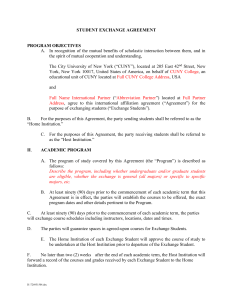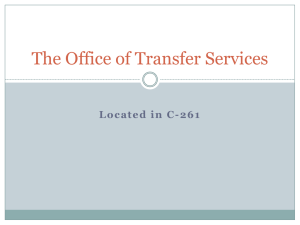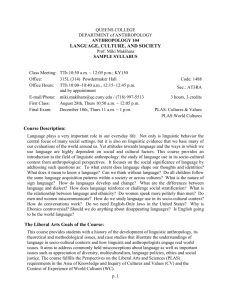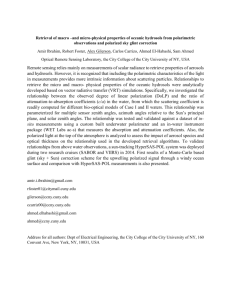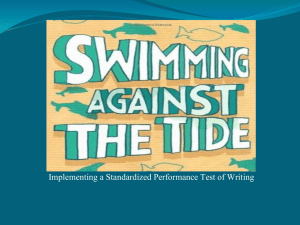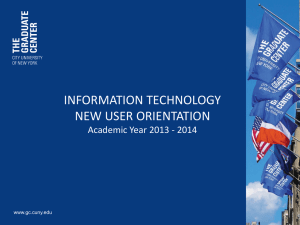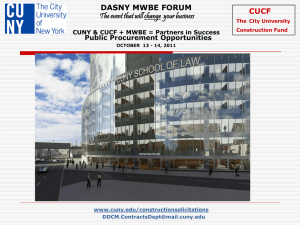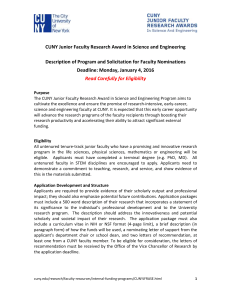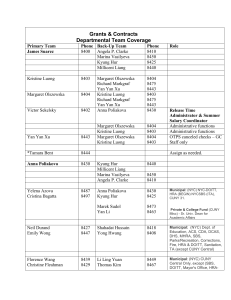Slides - ICELW
advertisement
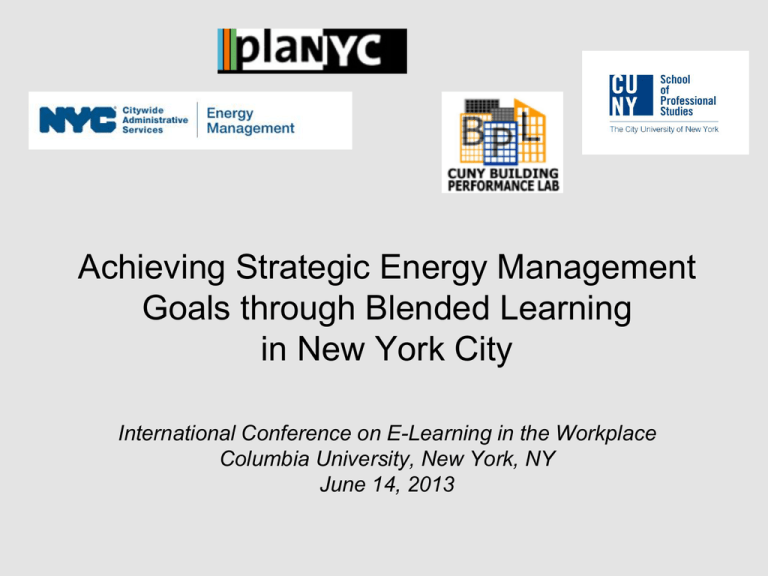
Achieving Strategic Energy Management Goals through Blended Learning in New York City International Conference on E-Learning in the Workplace Columbia University, New York, NY June 14, 2013 …or “How to maximize performance outcomes by bringing your learning strategy into the 21st Century.” Presenters: Michael Dipple, DCAS Energy Management Michael Bobker, CUNY Building Performance Lab Patrick Dail, CUNY School of Professional Studies Agenda • The City’s Energy Strategy context • Objectives of the Building Operator program – Pedagogy & Content – Deciding what goes Online and what stays in the Classroom • Demo selected program modules PlaNYC is the City’s sustainability roadmap. 10 Sustainability Goals 9 Hallmark of the Plan: 30% GHG emission reduction by 2017. Going from PlaNYC To 30% x 2017 … • Benchmarking • Energy Audits & Retrofits • Operations & Maintenance • Training & Outreach • Clean Distributed Generation First step, investigate the City’s emissions sources. Source of City of New York Government GHG Emissions Total = 3.76 MMT Water supply, 1% Wastewater treatment, 16% Vehicle fleet, 9% Buildings, 62% Streetlights and traffic signals, 3% Solid waste, 9% Other 0.3% Next step, identify emissions reduction target areas. Source of Potential GHG Emissions Reductions Total = 1.68 MMT Emerging technology, 2% Wastewater treatment plants 17% New construction 1% Vehicles 5% Street lighting, 3% Solid waste management 11% Clean distributed generation, 4% Existing buildings 57% Retrofits & replacements 45% Operations & maintenance 12% DCAS Energy Management O&M Overview Goals 1. Repair, maintain and operate existing equipment as efficiently as possible 2. Increase training and outreach to improve skills and raise energy awareness 3. Provide management oversight, accountability and transparency What is hoped for from Operator training? Goals 1. 10% - 15% energy savings from improved O&M 2. Training as one element in O&M program 3. Findings from evaluations of BOC training nationally - 2.5% ?? Targeted Training Audience: Greening the grizzly skeptic Facility Operators Targeted Training Audience: Facility Operators • Get more of engineering staff into classes • Difficulty with taking shift stationary engineers off site • Motivation for developing on-line lessons Building Operator Certification-Level I 60 hour Training Program involving classroom lessons, practical projects and exams. Primary Topics: • HVAC Systems, Equipment and Controls • HVAC Calculation and Retro-commissioning • Electrical Systems and Equipment • Energy Data and its use in Operations • Energy Audits – participation, reading, and use • Integrated Energy-related Maintenance Practice and development of operational projects Building Operator Certification-Level I Pedagogy & Objectives • Combine theory & practice • Engage audience in professionalization & new mission • Lead to measurable changes in facility operations On-line vs In-class • Separating pure content from skill/practice • Apply content to realworld, work situations • exercises • Lead to PROJECTS in home facilities Understand systems’ operations • Trace out equipment and draw simple schematics • Sketching facilitates observation of equipment operations • Instructor helps students • know what to look for • get started in drawing • Record relevant notes Collecting and using data, reading graphs What data to collect for specific purposes? • Thermal comfort • Ventilation • Lighting levels • Electrical maintenance • Energy use – absolute and relative Use of hand-held tools & data-loggers Use of computer (web) – based tools USE ENGINEERING TABLES AND CHARTS Basic engineering concepts, such as flow and pressure relationship on pump/fan curves Get operators over fear of basic calculations, unfamiliar methods for adjusting equipment Blended Building Operator Certification Training Program • Our definition of “blended” – Use of ILT and OL formats • Conservative Initial Approach – Syllabus & Instructional Schedule – Beginning to re-think that strategy • Culture Change for our audience – Projected ~ 7 hrs to take all 14 modules over time – Have found that they are spending 14.5 – 15.25 hrs in total in the lessons – Demand from prior learners • Culture Change for the training professionals – Sourced a vendor to support development of the assets – Sourced an LMS to host delivery and track progress Resources to help your work: PlaNYC – New York City’s Sustainability Roadmap: www.nyc.gov.planyc CUNY Building Performance Lab: http://www.cunybpl.org/ Deputy Commissioner Ariella Maron, podcast interview www.greentechmedia.com PlaNYC Case Study, C40 Cities Climate Leadership Group: http://www.c40cities.org/ Michael Bobker, Executive Director CUNY Building Performance Lab Desk: 646.660.6977 Email: Michael_Bobker@baruch.cuny.edu Patrick Dail, Training Director, CUNY School of Professional Studies Desk: 212.817.7248 Email: Patrick.Dail@mail.cuny.edu Michael Dipple, Director, Energy Efficiency Planning, DCAS Energy Management Desk: 212.386.0371 Email: Mdipple@dcas.nyc.gov
